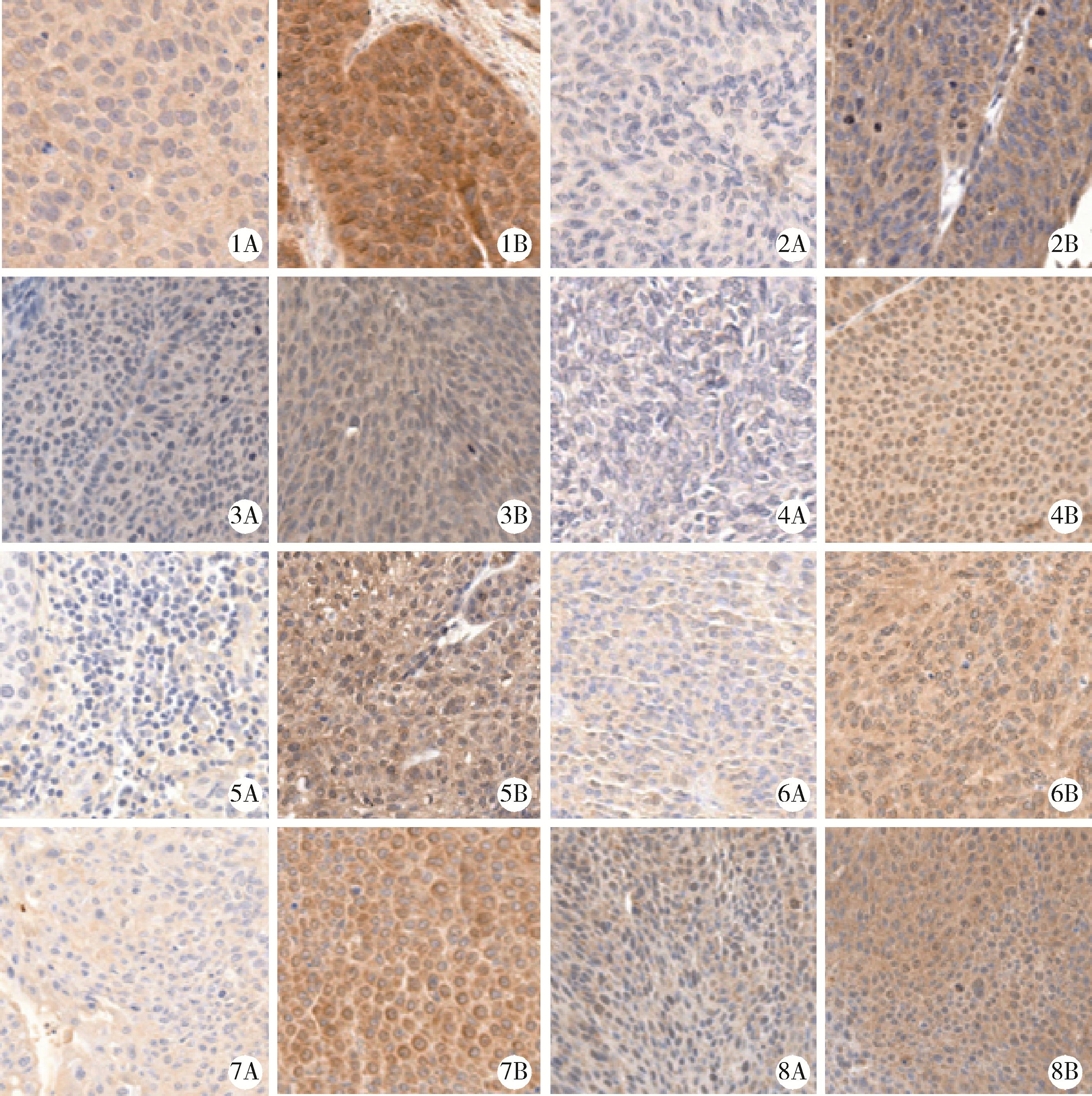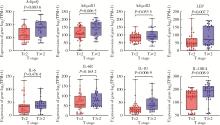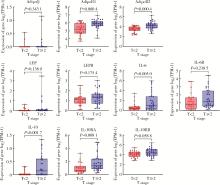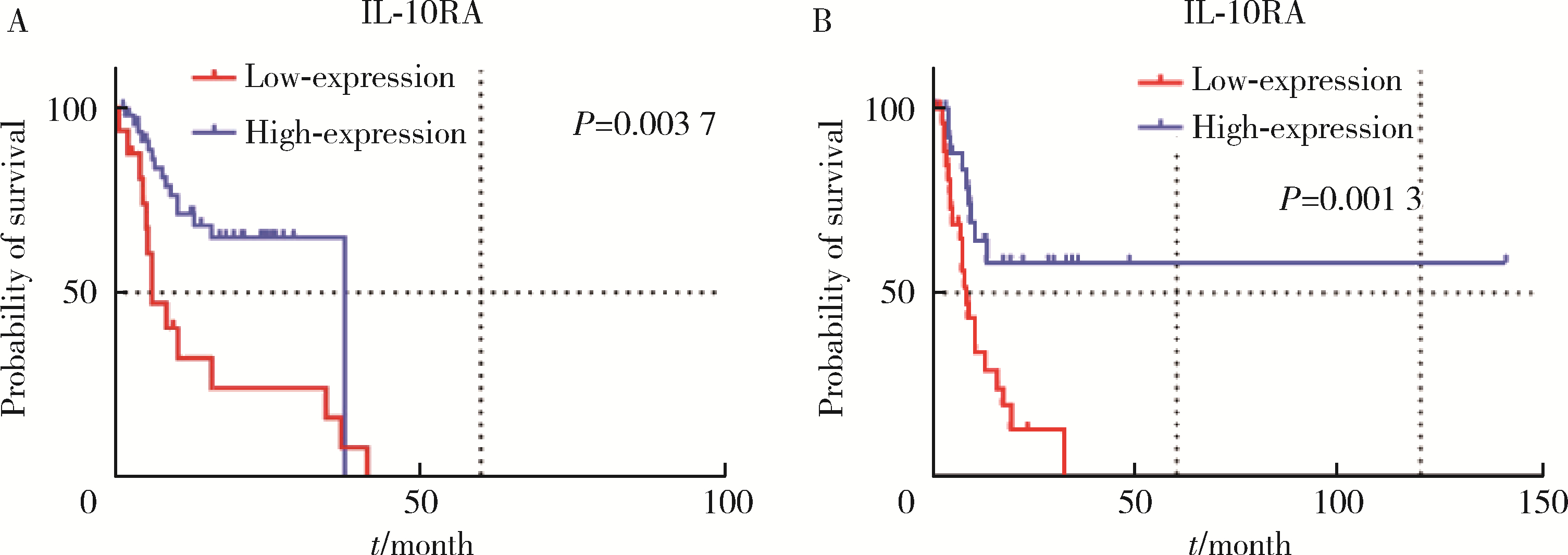Journal of Peking University (Health Sciences) ›› 2022, Vol. 54 ›› Issue (4): 605-614. doi: 10.19723/j.issn.1671-167X.2022.04.005
Previous Articles Next Articles
Correlation between adipokine and clinicopathological features and prognosis in upper tract urothelial carcinoma
Xiang DAI,Fei WANG,Yi-qing DU,Yu-xuan SONG,Tao XU*( )
)
- Department of Urology, Peking University People's Hospital, Beijing 100044, China
CLC Number:
- R737.1
| 1 |
Siegel RL , Miller KD , Jemal A . Cancer statistics, 2019[J]. CA Cancer J Clin, 2019, 69 (1): 7- 34.
doi: 10.3322/caac.21551 |
| 2 | 黄健. 中国泌尿外科和男科疾病诊断治疗指南(2019版)[M]. 北京: 科学出版社, 2019. |
| 3 |
Rouprêt M , Babjuk M , Burger M , et al. European Association of Urology Guidelines on upper urinary tract urothelial carcinoma: 2020 Update[J]. Eur Urol, 2021, 79 (1): 62- 79.
doi: 10.1016/j.eururo.2020.05.042 |
| 4 |
Polito R , Nigro E , Fei L , et al. Adiponectin is inversely associa-ted with tumour grade in colorectal cancer patients[J]. Anticancer Res, 2020, 40 (7): 3751- 3757.
doi: 10.21873/anticanres.14364 |
| 5 |
Di Zazzo E , Polito R , Bartollino S , et al. Adiponectin as link factor between adipose tissue and cancer[J]. Int J Mol Sci, 2019, 20 (4): 839.
doi: 10.3390/ijms20040839 |
| 6 |
Hebbard L , Ranscht B . Multifaceted roles of adiponectin in cancer[J]. Best Pract Res Clin Endocrinol Metab, 2014, 28 (1): 59- 69.
doi: 10.1016/j.beem.2013.11.005 |
| 7 |
Perrier S , Jardé T . Adiponectin, an anti-carcinogenic hormone? A systematic review on breast, colorectal, liver and prostate cancer[J]. Curr Med Chem, 2012, 19 (32): 5501- 5512.
doi: 10.2174/092986712803833137 |
| 8 | Kashiwagi E , Abe T , Kinoshita F , et al. The role of adipocytokines and their receptors in bladder cancer: Expression of adiponectin or leptin is an independent prognosticator[J]. Am J Transl Res, 2020, 12 (6): 3033- 3045. |
| 9 |
Park EJ , Lee JH , Yu GY , et al. Dietary and genetic obesity promote liver inflammation and tumorigenesis by enhancing IL-6 and TNF expression[J]. Cell, 2010, 140 (2): 197- 208.
doi: 10.1016/j.cell.2009.12.052 |
| 10 |
Mannino MH , Zhu Z , Xiao H , et al. The paradoxical role of IL-10 in immunity and cancer[J]. Cancer Letters, 2015, 367 (2): 103- 107.
doi: 10.1016/j.canlet.2015.07.009 |
| 11 | Sato T , Terai M , Tamura Y , et al. Interleukin 10 in the tumor microenvironment: A target for anticancer immunotherapy[J]. Immunol Res, 2011, 51 (2/3): 170- 182. |
| 12 |
Lippitz BE , Harris RA . Cytokine patterns in cancer patients: A review of the correlation between interleukin 6 and prognosis[J]. Oncoimmunology, 2016, 5 (5): e1093722.
doi: 10.1080/2162402X.2015.1093722 |
| 13 |
Lee YC , Wu WJ , Lin HH , et al. Prognostic value of leptin receptor overexpression in upper tract urothelial carcinomas in Taiwan[J]. Clin Genitourin Cancer, 2017, 15 (4): e653- e659.
doi: 10.1016/j.clgc.2017.01.002 |
| 14 |
Holland WL , Miller RA , Wang ZV , et al. Receptor-mediated activation of ceramidase activity initiates the pleiotropic actions of adiponectin[J]. Nat Med, 2011, 17 (1): 55- 63.
doi: 10.1038/nm.2277 |
| 15 |
Hebbard LW , Garlatti M , Young LJ , et al. T-cadherin supports angiogenesis and adiponectin association with the vasculature in a mouse mammary tumor model[J]. Cancer Res, 2008, 68 (5): 1407- 1416.
doi: 10.1158/0008-5472.CAN-07-2953 |
| 16 |
Sun LY , Li XJ , Sun YM , et al. LncRNA ANRIL regulates AML development through modulating the glucose metabolism pathway of AdipoR1/AMPK/SIRT1[J]. Mol Cancer, 2018, 17 (1): 127.
doi: 10.1186/s12943-018-0879-9 |
| 17 |
Chou SH , Tseleni-Balafouta S , Moon HS , et al. Adiponectin receptor expression in human malignant tissues[J]. Horm Cancer, 2010, 1 (3): 136- 145.
doi: 10.1007/s12672-010-0017-7 |
| 18 |
Hsu TI , Wang YC , Hung CY , et al. Positive feedback regulation between IL10 and EGFR promotes lung cancer formation[J]. Oncotarget, 2016, 7 (15): 20840- 20854.
doi: 10.18632/oncotarget.7894 |
| 19 | Qian Q , Wu C , Chen J , et al. Relationship between IL10 and PD-L1 in liver hepatocellular carcinoma tissue and cell lines[J]. Biomed Res Int, 2020, 2020, 8910183. |
| 20 |
Satyam A , Singh P , Badjatia N , et al. A disproportion of TH1/TH2 cytokines with predominance of TH2, in urothelial carcinoma of bladder[J]. Urol Oncol, 2011, 29 (1): 58- 65.
doi: 10.1016/j.urolonc.2009.06.002 |
| 21 | Agrawal U , Kumari N , Mishra AK , et al. Immune signature of urothelial cancer associated with grade, recurrence, and invasion[J]. Urol Oncol, 2016, 34 (9): 418. |
| 22 |
Cai T , Mazzoli S , Meacci F , et al. Interleukin-6/10 ratio as a prognostic marker of recurrence in patients with intermediate risk urothelial bladder carcinoma[J]. J Urol, 2007, 178 (5): 1906- 1912.
doi: 10.1016/j.juro.2007.07.041 |
| 23 | Rabinovich A , Medina L , Piura B , et al. Expression of IL-10 in human normal and cancerous ovarian tissues and cells[J]. Eur Cytokine Netw, 2010, 21 (2): 122- 128. |
| 24 |
Ramos-Ramírez P , Malmhäll C , Tliba O , et al. Adiponectin/adipoR1 axis promotes IL-10 release by human regulatory T cells[J]. Front Immunol, 2021, 12, 677550.
doi: 10.3389/fimmu.2021.677550 |
| [1] | Zhi-hua LI,Chun-ru XU,Yin LIU,Hua GUAN,Meng ZHANG,Xin-yan CHE,Qi TANG,Yan-bo HUANG,Xue-song LI,Li-qun HOU. Correlation between daily fluid intake behavioral habits and pathological characteristics of upper tract urothelial carcinoma [J]. Journal of Peking University (Health Sciences), 2022, 54(4): 621-627. |
| [2] | Bao GUAN,Mai WENG,Hang FAN,Ding PENG,Dong FANG,Geng-yan XIONG,Xue-song LI,Li-qun ZHOU. Evaluating the impact of preoperative anemia on the prognosis of upper tract urothelial carcinoma following radical nephroureterectomy: A single-center retrospective study of 686 patients [J]. Journal of Peking University(Health Sciences), 2019, 51(6): 1056-1061. |
| [3] | Run-zhuo MA,Hai-zhui XIA,Min LU,Zhi-ying ZHANG,Qi-ming ZHANG,Jian LU,Guo-liang WANG,Lu-lin MA. Impact of diagnostic ureteroscopy and biopsy on radical nephroureterectomy of upper tract urothelial carcinoma [J]. Journal of Peking University(Health Sciences), 2019, 51(4): 665-672. |
| [4] | GUAN Bao, CAO Zhen-peng, PENG Ding, LI Yi-fan, ZHAN Yong-hao, LIU Li-bo, HE Shi-ming, XIONG Geng-yan, LI Xue-song, ZHOU Li-qun. Prognostic factors of patients with T2N0M0 upper tract urothelial carcinoma: a single-center retrospective study of 235 patients [J]. Journal of Peking University(Health Sciences), 2017, 49(4): 603-607. |
|
||







